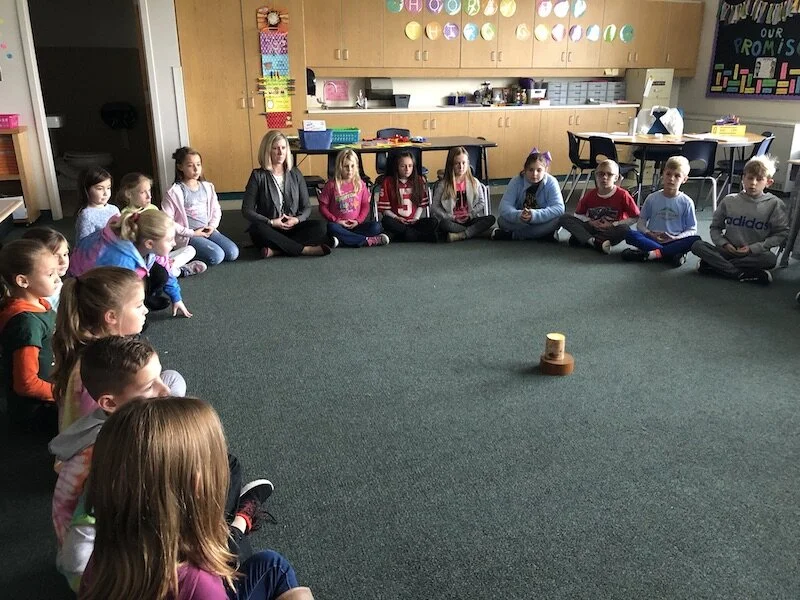Mindful Learning
Ask a second grader how the “Mindfulness” practices he has been learning each week in his classroom at Waterville Primary School can help him, and he is quick with a thoughtful response: “If you are having a problem and you take a ‘deep belly breath’ it really helps to take your mind off it. You think about breathing “in” when you breathe in and you think about breathing “out” when you breathe out. It could help you find a solution. It also helps you learn better.”
Beginning this fall, all students who attend the suburban elementary school in Northwest Ohio practice mindfulness techniques once a week under the direction of Jenn McCullough, a coach with the Toledo Mindfulness Institute. A former teacher and licensed intervention specialist, Ms McCullough visits up to seven classrooms twice a week to reach all students and teachers, grades K-4, in the building. She meets with each class in its own room where students sit side-by-side on the floor in a large circle. A candle burns in the center, setting a calm and relaxed tone for the 25-minute time period.
Ms. McCullough begins each session by asking students what they have experienced the past few days and if they had practiced the mindfulness strategy they learned the prior week. She then introduces them to a new technique, adding to the toolbox of strategies the children can use to calm themselves in stressful situations or to help them better focus on tasks they need to complete.
Ms. McCullough demonstrates how to blow a calming Bubble Breath by blowing out with a long, medium pressure breath.
“This offers us the opportunity to focus on social emotional learning and helps our students develop skills they will need to be successful adults.”
“Our students and teaching staff are asked to perform at consistently high levels of academic rigor while collaborating and problem solving with peers, but often, they are not directly taught the social emotional skills needed to successfully accomplish the task,” explains Principal Jamie Hollinger, who received a grant from the Martha Holden Jennings Foundation to implement a yearlong Mindfulness program at the school. “This offers us the opportunity to focus on social emotional learning and helps our students develop skills they will need to be successful adults: focus, relationship building, learning how to identify and communicate about their feelings, and how to take positive action accordingly.”
Mindfulness content and practices will be taught at Waterville over the course of the school year to ensure that these SEL skills become a systemic part of the school’s multidisciplinary curriculum. Initially, Ms. McCullough will lead all classroom sessions modeling for the teachers. As teachers advance in their own learning, they will transition to leading the learning on a daily basis and will continue to teach the strategies beyond 2020 without outside support.
Educators at Waterville first learned of the benefits of mindfulness practices through the school counselor, Jillian Cowell. Ms. Cowell says her interest in the topic grew as she noticed it appearing more often in journals, books, and articles she consulted in her professional work.
“I kept hearing mindfulness, mindfulness, mindfulness,” she exclaims, “and the more I looked into it, the more I realized I was not prepared to teach it in a way that I was comfortable with. It was a foreign idea to me; I had never tried it.”
Ms. Cowell first learned of an introductory Mindfulness class offered by the Toledo Mindfulness Institute last year and signed up for it along with the school’s art teacher, Jean McIntyre. During the 6-weeks of lessons, they gained a clearer understanding of the purpose of mindfulness practices, which the Institute defines as developing the “mind’s ability to skillfully respond to external and internal situations, lessening overall levels of stress and contributing to greater happiness.” That first experience led both educators to complete a second, 6-week course titled “Mindfulness in Education,” which explored topics relevant to both students and teachers. .
“I immediately came to school after one of those classes and had at least 15 ideas that I wanted to implement right away,” remarks Ms. Cowell, explaining how quickly she recognized the potential benefits mindfulness practices could have for her students.
Several weeks into the program, Ms. Cowell has noticed the clear and easily understandable language Ms. MCullough uses to connect with students during the classroom sessions. Recently, she explained the concept of Bubble Breathing to students as young as kindergarten. She asked the children to practice blowing the biggest imaginary bubble they could (using an invisible jar of bubbles) by controlling the pressure and speed of their breath. Too soft and slow and no bubble will form; too hard and fast and the bubble will immediately burst. The children quickly realized that medium pressure for a long time was ideal. After practicing five bubble breaths, the children described how they felt: calm, relaxed, sleepy, focused, and “super not stressful.”
Ms. McCullough assures the students they can use bubble breathing to help them deal with anxious feelings, for instance when they have to do something they don’t want to do. “Think how powerful five bubble breaths are,” she remarks. “And they are invisible. You can use invisible bubbles all the time. They aren’t real, yet they are powerful.”
“This is totally new to our school,” explains Dr. Hollinger who has already noticed a positive impact on student behavior just two months into the program. “It’s applicable for every student. I also think it is going to yield positive results for our staff, because they are practicing the mindfulness techniques and exercises themselves. It’s not age specific by any means, so it’s really helping us as adults to be focus. When we start to feel stress or anxiousness, we are able to self calm by implementing what Jenn McCullough is teaching us as well.”



